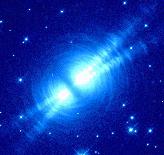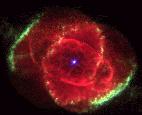 |
An HST image of the Cygnus Egg (AFGL 2688) in scattered light.
Astronomers classify the Egg as a proto planetary nebula, i.e. an
evolved star which has blown off much of its outer envelope, but has
not completely exposed its hot stellar interior. When this happens,
the outer envelope will become ionized and we'll be looking at a
young planetary nebula. The Egg has not yet reached this stage, so
we're seeing light scattered from the dust around the source.
Even though the central star is spherical, the geometry of the
scattered light is very complicated. One of the outstanding
mysteries in the study of how stars die is how this
highly non-spherical geometry develops. |

